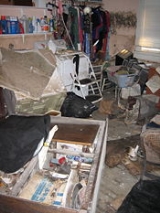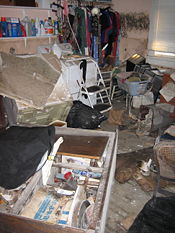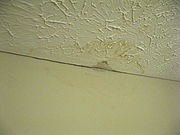
Water damage
Encyclopedia


Material
Material is anything made of matter, constituted of one or more substances. Wood, cement, hydrogen, air and water are all examples of materials. Sometimes the term "material" is used more narrowly to refer to substances or components with certain physical properties that are used as inputs to...
or system
System
System is a set of interacting or interdependent components forming an integrated whole....
by destructive processes such as rot
ROT
The aviation term ROT stands for rate one turn, also known as a standard rate turn. All aircraft must be able to perform a standard rate turn....
ting of wood, growth, rust
Rust
Rust is a general term for a series of iron oxides. In colloquial usage, the term is applied to red oxides, formed by the reaction of iron and oxygen in the presence of water or air moisture...
ing of steel
Steel
Steel is an alloy that consists mostly of iron and has a carbon content between 0.2% and 2.1% by weight, depending on the grade. Carbon is the most common alloying material for iron, but various other alloying elements are used, such as manganese, chromium, vanadium, and tungsten...
, de-laminating of materials such as plywood
Plywood
Plywood is a type of manufactured timber made from thin sheets of wood veneer. It is one of the most widely used wood products. It is flexible, inexpensive, workable, re-usable, and can usually be locally manufactured...
, and many, many others.
The damage may be imperceptibly slow and minor such as water spot
Water spot
A water spot is an area of dried mineral deposits left on a surface after being allowed to air dry. Water quality, specifically the amount and type of minerals in the local water supply as measured by the total suspended solids or TSS test and other mineral levels such as sodium level, has a big...
s that could eventually m ar a surface, or it may be instantaneous and catastrophic such as flooding. However fast it occurs, water damage is a very major contributor to loss of property.
One's homeowner's insurance policy may or may not cover the costs associated with water damage and the process of water damage restoration
Water damage restoration
Water damage restoration is the process of restoring a property back to pre-loss condition after sustaining any level of water damage. While there are currently no government regulations in the United States dictating procedures, two large certifying bodies, the IICRC and the RIA, do recommend...
. While a common cause of residential water damage is often the failure of a sump pump, many homeowner's insurance policies do not cover the associated costs without an addendum which adds to the monthly premium of the policy. Often the verbiage of this addendum is similar to "Sewer and Drain Coverage."
Those individuals who are affected by wide scale flooding may have the ability to apply for government and FEMA grants through the Individual Assistance program. On a larger level, businesses, cities, and communities can apply to the FEMA Public Assistance
FEMA Public Assistance
The Federal Emergency Management Agency's Public Assistance Program provides aid in the wake of a major disaster to state and local governments, and to certain non-profits, to help communities in their recovery efforts....
program for funds to assist after a large flood. For example, the city of Fond du Lac Wisconsin received $1.2 million FEMA grant after flooding in June 2008. The program allows the city to purchase the water damaged properties, demolish the structures, and turn the properties into public green space.
Causes
Water damage can originate by different sources such as: broken dishwasher hose, washing machine overflow, dishwasher leakage, broken pipes, clogged toilet, leaking roof, moisture behind walls, foundation cracks, plumbing leaks, and bad weather (snow, rain, floods). As far as insurance coverage is concerned, most damage caused by bad weather is considered flood damage and normally isn't covered under homeowners insurance. Coverage for bad weather would usually required flood insurance.Categories
Water damage is typically classified into one of the following three categories:Category 1 Water - Refers to a source of water that does not pose substantial threat to humans and classified as "Clean Water". Examples are broken water supply
Water supply
Water supply is the provision of water by public utilities, commercial organisations, community endeavours or by individuals, usually via a system of pumps and pipes...
lines, tub or sink overflows or appliance malfunctions that involves water supply lines.
Category 2 Water - Refers to a source of water that contains a significant degree of chemical, biological or physical contaminants and causes discomfort or sickness when exposed or even consumed. Known as "Grey Water". This type carries micro organisms and nutrients of micro organisms. Examples are toilet bowls with urine
Urine
Urine is a typically sterile liquid by-product of the body that is secreted by the kidneys through a process called urination and excreted through the urethra. Cellular metabolism generates numerous by-products, many rich in nitrogen, that require elimination from the bloodstream...
(no feces
Feces
Feces, faeces, or fæces is a waste product from an animal's digestive tract expelled through the anus or cloaca during defecation.-Etymology:...
), sump pump
Sump pump
A sump pump is a pump used to remove water that has accumulated in a water collecting sump basin, commonly found in the basement of homes. The water may enter via the perimeter drains of a basement waterproofing system, funneling into the basin or because of rain or natural ground water, if the...
failures, seepage due to hydrostatic failure and water discharge from dishwashers or washing machines.
Category 3 Water - Known as "Black Water" and are grossly unsanitary. This water contains unsanitary agents, harmful bacteria
Bacteria
Bacteria are a large domain of prokaryotic microorganisms. Typically a few micrometres in length, bacteria have a wide range of shapes, ranging from spheres to rods and spirals...
and fungi, causing severe discomfort or sickness. Type 3 category are contaminated water sources that affects the indoor environment. This category includes water sources from sewage
Sewage
Sewage is water-carried waste, in solution or suspension, that is intended to be removed from a community. Also known as wastewater, it is more than 99% water and is characterized by volume or rate of flow, physical condition, chemical constituents and the bacteriological organisms that it contains...
, seawater, rising water from rivers or streams, ground surface water or standing water. Category 2 Water or Grey Water that is not promptly removed from the structure and or have remained stagnant for 48-72 hours may be re classified as Category 3 Water. Toilet back flows that originates from beyond the toilet trap is considered black water contamination regardless of visible content or color.
Classes
Class of water damageWater damage restoration
Water damage restoration is the process of restoring a property back to pre-loss condition after sustaining any level of water damage. While there are currently no government regulations in the United States dictating procedures, two large certifying bodies, the IICRC and the RIA, do recommend...
is determined by the probable rate of evaporation based on the type of materials affected, or wet, in the room or space that was flooded. Determining the Class of Water is an important first step, and will determine the amount and type of equipment utilized to dry-down the structure:.
Class 1 - Slow Rate of Evaporation
Evaporation
Evaporation is a type of vaporization of a liquid that occurs only on the surface of a liquid. The other type of vaporization is boiling, which, instead, occurs on the entire mass of the liquid....
. Affects only a portion of a room. Materials have a low permeance/porosity. Minimum moisture is absorbed by the materials.
Class 2 - Fast Rate of Evaporation. Water affects the entire room of carpet and cushion. May have wicked up the walls, but not more than 24 inches.
Class 3 - Fastest Rate of Evaporation. Water generally comes from overhead, affecting the entire area; walls, ceilings, insulation, carpet, cushion, etc.
Class 4 - Specialty Drying Situations. Involves materials with a very low permeance/porosity, such as hardwood floors, concrete, crawlspaces, plaster, etc. Drying generally requires very low specific humidity
Humidity
Humidity is a term for the amount of water vapor in the air, and can refer to any one of several measurements of humidity. Formally, humid air is not "moist air" but a mixture of water vapor and other constituents of air, and humidity is defined in terms of the water content of this mixture,...
to accomplish drying.
Restoration
Different removal methods and measures are used depending on the category of water. Due to the destructive nature of water, restoration methods also rely heavily on the amount of water, and on the amount of time the water has remained stagnant. For example, as long as carpet has not been wet for longer than 48 hours, and the water involved was not sewage based, you can usually save the carpet; however, if the water has soaked for longer, then your carpet is probably irreparable and will have to be replaced. Water damage restorationWater damage restoration
Water damage restoration is the process of restoring a property back to pre-loss condition after sustaining any level of water damage. While there are currently no government regulations in the United States dictating procedures, two large certifying bodies, the IICRC and the RIA, do recommend...
can be performed by property management
Property management
Property management is the operation, control of ususally on behalf of an owner, and oversight of commercial, industrial or residential real estate as used in its most broad terms. Management indicates a need to be cared for, monitored and accountability given for its usable life and condition...
teams, building maintenance
Maintenance, Repair and Operations
Maintenance, repair, and operations or maintenance, repair, and overhaul involves fixing any sort of mechanical or electrical device should it become out of order or broken...
personnel, or by the homeowners themselves; however, contacting a certified professional water damage restoration specialist is often regarded as the safest way to restore water damaged property due to their training and extensive experience. Most are usually listed under "Fire and Water Restoration" and they can help speed repairs, whether for individual homeowners or for the largest of institutions. Fire and Water Restoration companies are reg ulated by the appropriate state's Department of Consumer Affairs - usually the state contractors license board. In California, all Fire and Water Restoration companies must register with the California Contractors State License Board. Presently, the California Contractors State License Board has no specific classification for "water and fire damage restoration." Hence, the Contractor's State License Board requires both an asbestos certification (ASB) as well as a demolition classification (C-21) in order to perform Fire and Water Restoration work.

